Planning a trip out west and wondering what the best geyser basins in Yellowstone are? Should you plan to see all 11 of them, or are some worth skipping?
My husband and I spent 5 days in Yellowstone National Park during the summer of 2023 and we visited 10 out of all 11 of the geyser basins in Yellowstone.
The hot springs, fumaroles, geysers, and mud pots are some of the most unique scenery I’ve ever seen! But after a few days, it can get a bit repetitive.
And if you have less than 4-5 days in the park, it will be difficult to see all 11 geyser basins as well. There are so many amazing things to do and see in Yellowstone that it can be hard figuring out which areas to prioritize on your trip!
This post has all 11 of Yellowstone’s geyser basins ranked from my perspective to help you plan, prioritize, and make the most of your Yellowstone National Park trip!
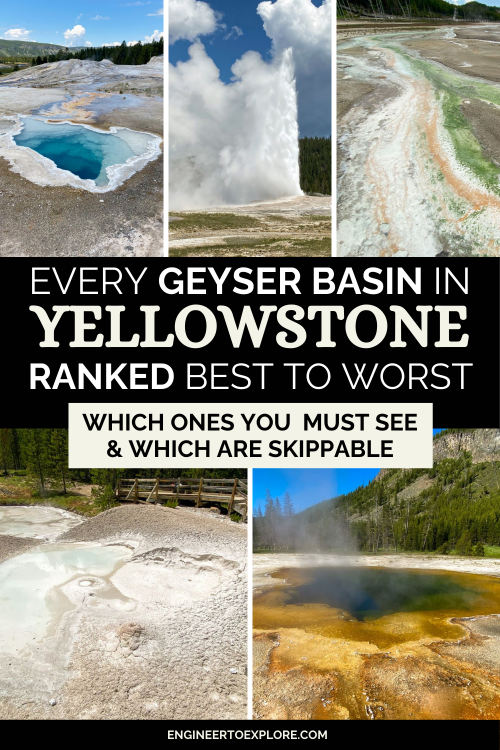
About Geyser Basins in Yellowstone
Yellowstone National Park sits on top of one of the largest volcanoes in the world!
The term “geyser basin” when we’re talking about Yellowstone refers to a specific area of hydrothermal activity. Each area has a boardwalk trail that takes you through the basin.
A geyser basin will have one or more of the following 5 hydrothermal features:
- Geysers: Underwater hot springs that are under pressure and periodically erupt water and steam.
- Mud pots: Bubbling, acidic hot springs with limited water that “melt” rocks around them to form a bubbling pool of what looks like mud. Mud pots are more runny from the rain and snowmelt in the spring and dry up throughout the summer.
- Fumaroles: Openings that vent steam and sulfur gases.
- Hot springs: Colorful hot pools that are home to different species of bacteria. You’ll often see steam rising from them (especially in the morning) due to the temperature difference of the water and atmosphere.
- Travertine terraces: A build up of travertine limestone formed by calcium carbonate minerals deposited by hot springs.
It is super important that you stay on the boardwalks when visiting geyser basins. These areas are very fragile and dangerous, so staying on the boardwalks will protect you and the land.
The hot springs are boiling hot and acidic, plus the ground around them could be just a thin crust over the spring, meaning you could fall through it if you venture off the boardwalk trail.
Pets are also not allowed on the boardwalks.
It should go without saying, but swimming in any hot spring in Yellowstone National Park is prohibited.
Unfortunately, people have died from falling into hot springs in Yellowstone. Please do your part by staying on the boardwalks, walking carefully, and not touching any of the thermal features!
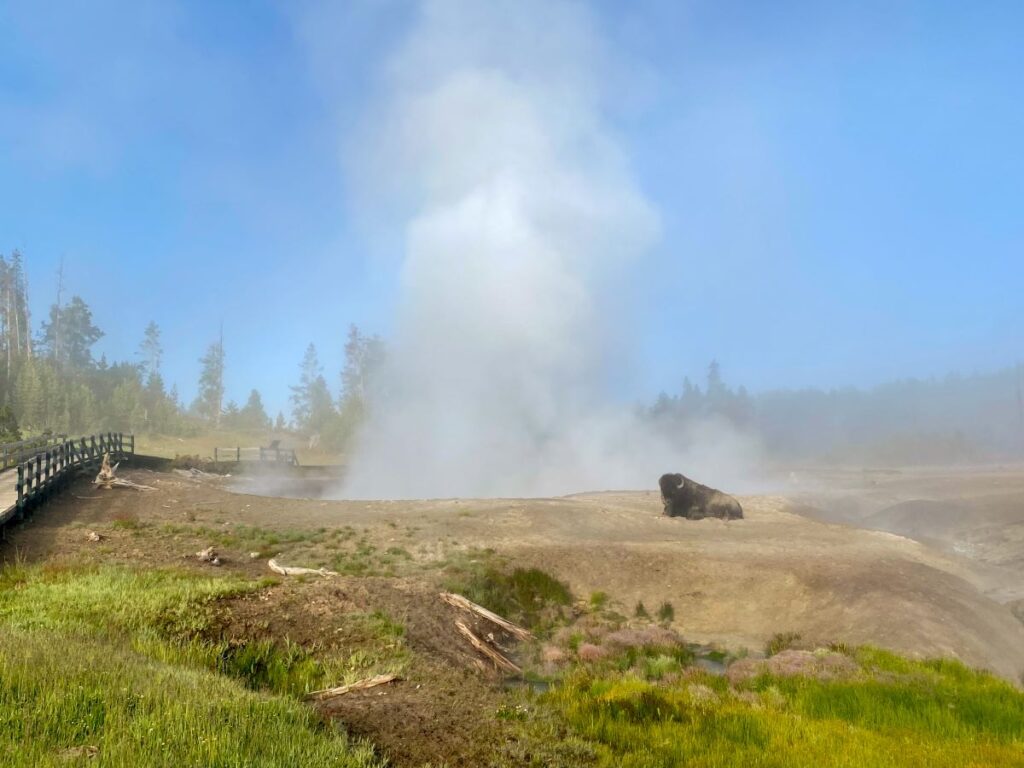
The Best Time to Visit Geyser Basins in Yellowstone
The best time to visit geyser basins in Yellowstone is in the summer. Most of the park roads are closed from October to May, so you won’t see any geyser basins if you travel during this time (check hours for each region on the NPS website here).
Yes, the summer will have large crowds, but the direct sunlight will really make the colors in the hot springs pop midday! It is worth braving the crowds to see those colors.
Related: 12 Essential Tips for Visiting Yellowstone in the Summer
11 Geyser Basins in Yellowstone Ranked
I’ve ordered all 11 of the geyser basins in Yellowstone from north to south below. Each one has a ranking of “must see,” “nice to see,” and “skippable.”
I’ve also listed the length and elevation of the boardwalk trails, the time required to visit, which hydrothermal features you’ll see, and the best time of day to visit.
If you only have 1 or 2 days in the park, the “must see” geyser basins will help you know which ones you definitely need to hit, and the “nice to see” ones you can add on if you have more time.
And just because I categorized a geyser basin as “skippable” doesn’t mean that it isn’t amazing to see as well. “Skippable” simply means that I think there are other geyser basins with similar features and scenery ranked higher.
You’ll see all 5 of the geothermal features (geysers, mudpots, fumaroles, hot springs, and travertine terraces) if you visit all of the “must-see” locations.
Related: The Ultimate Yellowstone Bucket List: Top 17 Things to See & Do
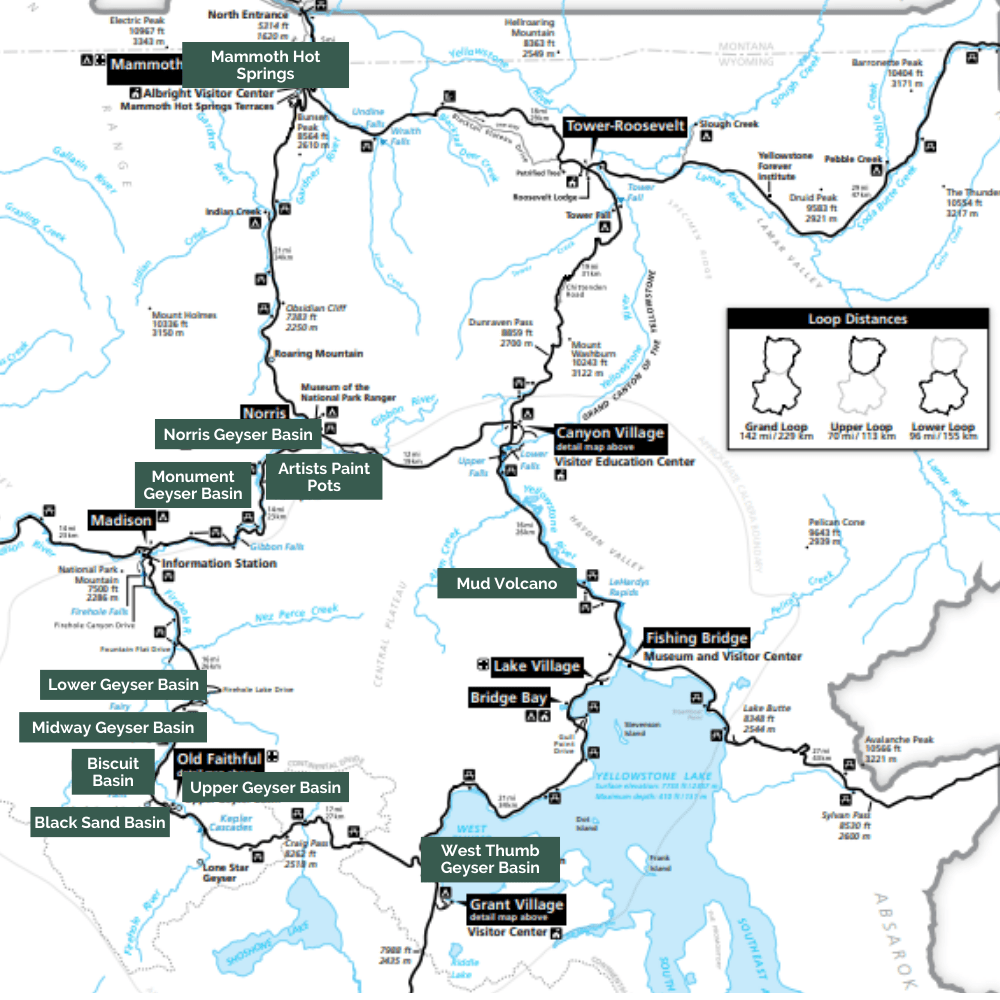
Mammoth Hot Springs – Must See
Length of hike: 2.2 miles / 324 feet of elevation gain
Time to visit: 1.5 – 2 hours
Hydrothermal features: hot springs, travertine terraces
Best feature: the only place to see travertine terraces
Best time of day to visit: early morning or late afternoon/evening
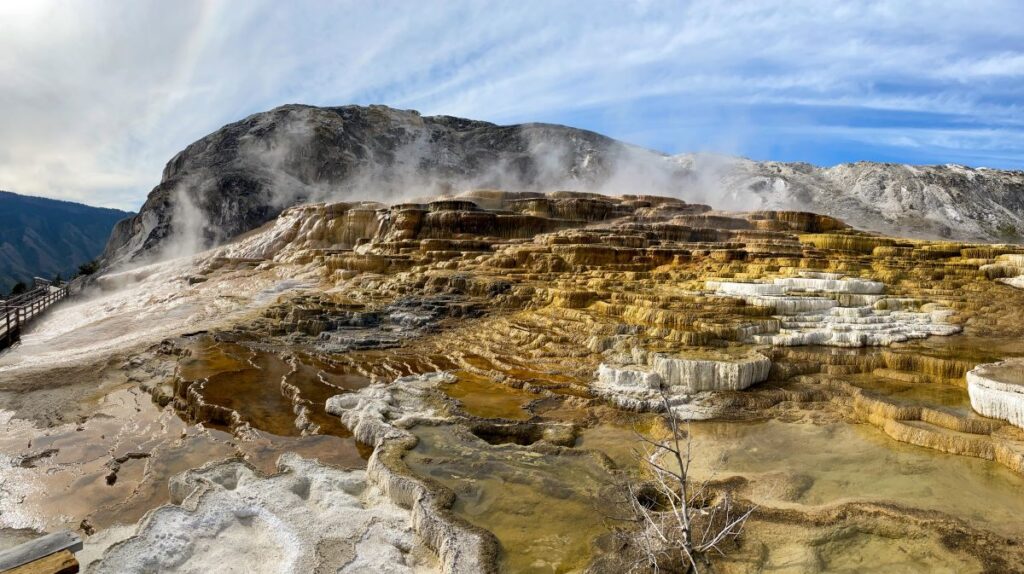
The Mammoth Hot Springs made the “must see” list because this is the only place to see the travertine terraces in the whole park.
The Mammoth Hot Springs do live up to their name- they are huge! Admire these ever-changing terraces filled with water and bacteria creating the perfect copper colors draping over layers of travertine.
The boardwalks here are split into the upper and lower terraces. You can hike between them (stats shown above are for hiking both terraces) or drive to each area separately.
We started at the lower terraces and hiked up to the upper terraces. I’d recommend getting an early start here, as parking at the lower terraces fills up quick!
Related: A Complete Guide to the Yellowstone North Entrance & Mammoth Hot Springs
Norris Geyser Basin – Nice to See
Length of hike: 3 miles / 190 feet of elevation gain
Time to visit: 2 hours
Hydrothermal features: geysers, hot springs, fumaroles
Best feature: variation in colors
Best time of day to visit: late afternoon or evening
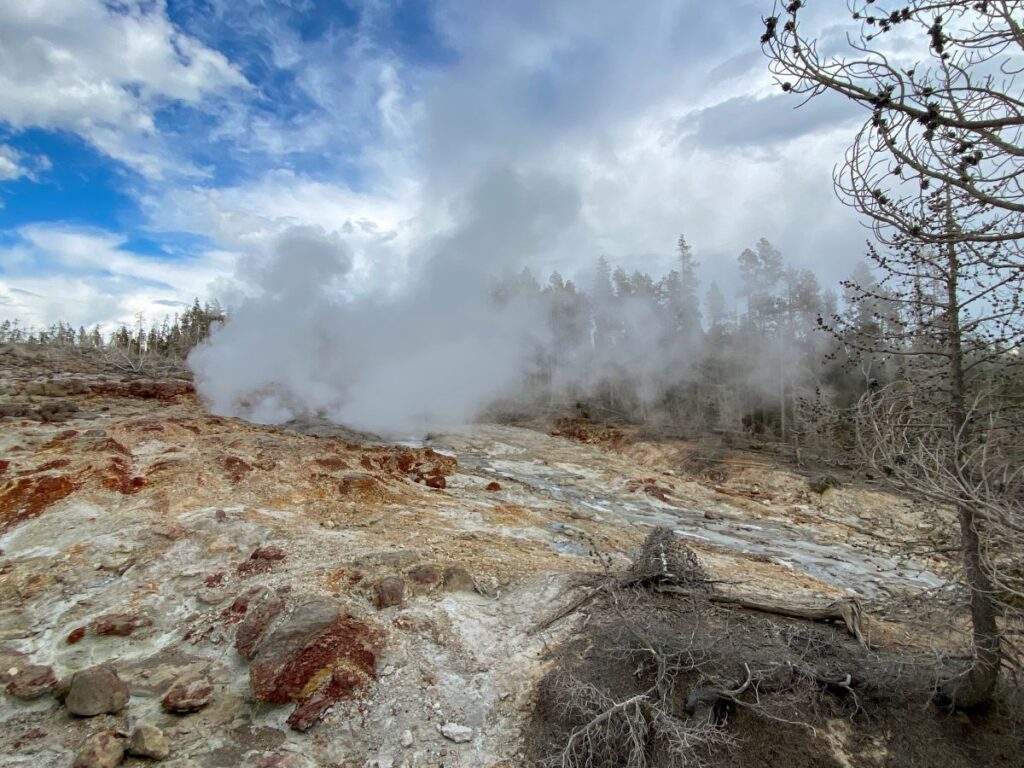
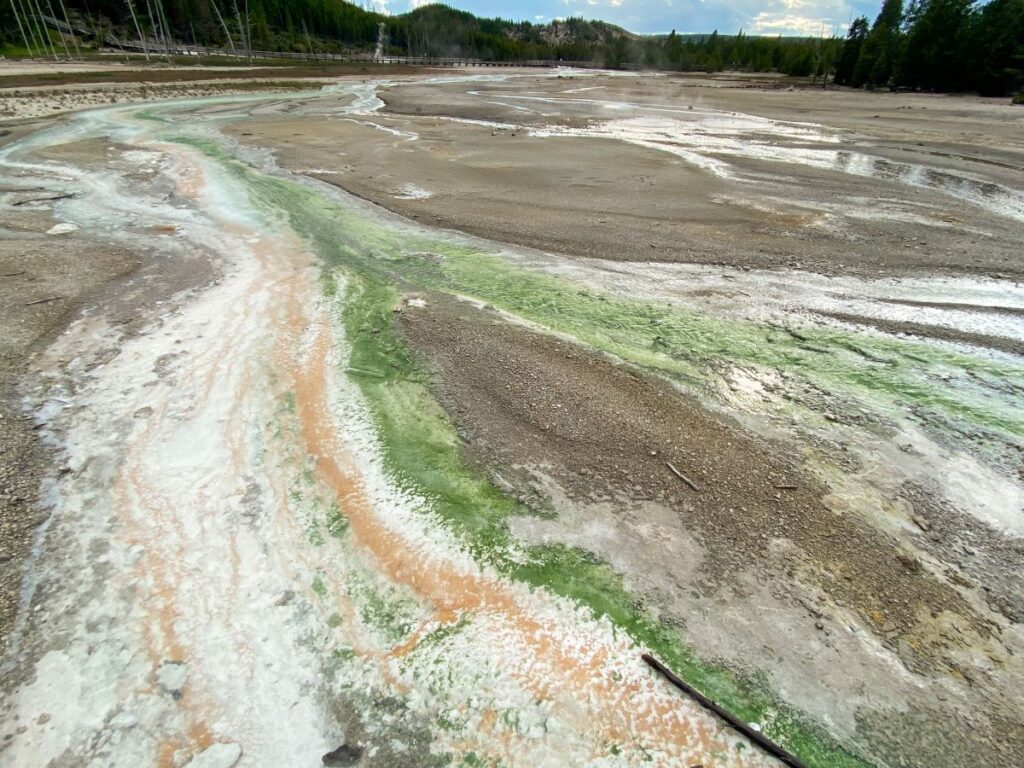
Norris Geyser Basin is the hottest, oldest, and most dynamic geyser basin in Yellowstone. The variation in colors and features here blew me away!
It’s also home to Steamboat Geyser, the tallest active geyser in the world. Eruptions are now pretty regular, but unpredictable. Eruption heights can reach more than 300 feet high (Old Faithful is 90 – 184 feet for reference)!
This area has 2 boardwalk loops: the Porcelain Basin and the Back Basin. It will take you about 2 hours to walk both boardwalk loops, and it’s definitely worth seeing both.
Norris has a pretty big parking lot, but going midday will still result in tons of cars lining the road. We went around 5 pm after a light rain and there was plenty of parking. The whole experience was very peaceful without the crowds, and we even saw a rainbow on the way out!
I heavily debated categorizing Norris Geyser Basin as “must see,” but felt that having half of the geyser basins in Yellowstone ranked as “must see” would be too many “must sees” (that’s a testament to how truly wonderful Yellowstone National Park is!). You can see similar features in the Upper Geyser Basin, so that is ultimately why I ranked it “nice to see.”
But of all the “nice to sees,” Norris is easily the top. TLDR: if you’re planning a trip to Yellowstone I highly recommend visiting Norris Geyser Basin!
Artists Paint Pots – Must See
Length of hike: 1 mile / 100 feet of elevation gain
Time to visit: 30 minutes
Hydrothermal features: mudpots, hot springs
Best feature: aerial view of mudpots, lower crowds
Time to visit: midday or late afternoon
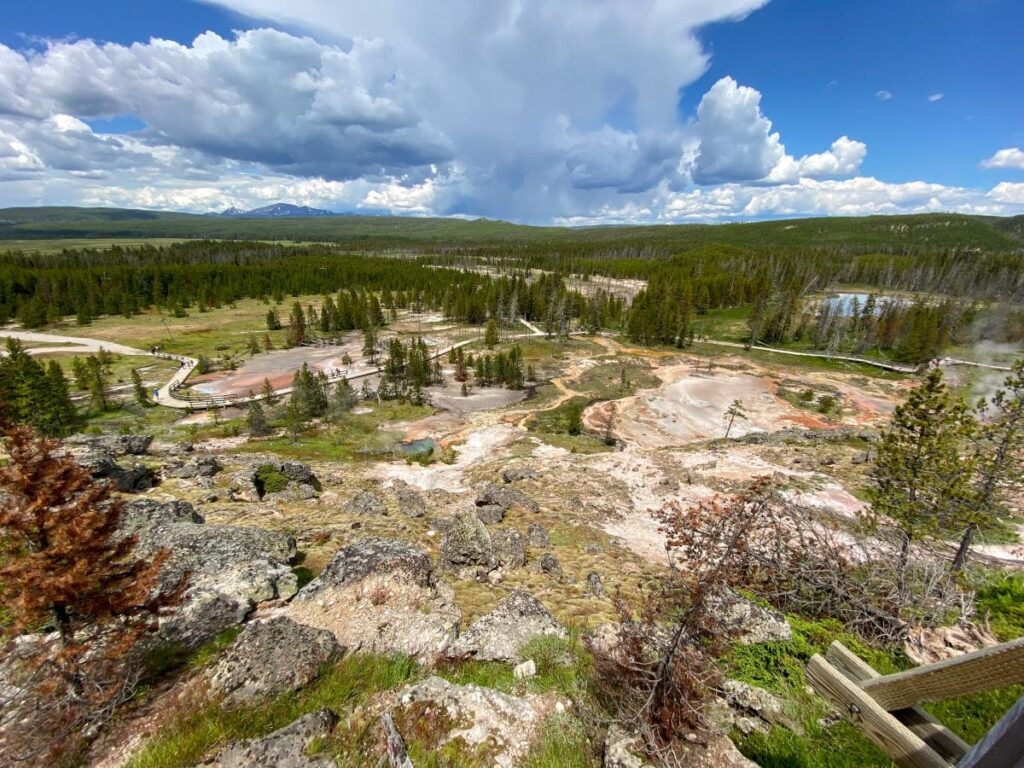
The Artists Paint Pots is such a hidden gem in my opinion. It’s collection of small, colorful mud pots and hot springs with a short hike to an incredible overlook over the entire geyser basin.
The bubbling sounds, sulfur smell, and dazzling red and blue colors of this area are forever burned into my brain. None of the other mud pots we saw in Yellowstone were as brightly colored and unique as the ones at Artists Paint Pots.
This area is just south of Norris Geyser Basin, so I can only assume that Norris overshadows the Artists Paint Pots since it is a much bigger basin. But that’s good news for you, since there are much lower crowds here.
The hike here is short and sweet, so it’s easy to add on to a visit to Norris Geyser Basin. There is a little bit of elevation gain, but it is so worth it for that view over the basin!
We went midday and were able to get a parking space (the lot was pretty full, but there weren’t miles of cars parked along the road like at other geyser basins in Yellowstone).
Due to the uniquely-colored mud pots, overlook over the basin, low crowd factor, and how quickly you can visit, it was easy to rank the Artists Paint Pots as “must see.”
Monument Geyser Basin – Skippable
Length of hike: 2.3 miles / 675 feet of elevation gain
Time to visit: 2 hours
Hydrothermal features: mud pots, fumaroles
Best feature: sinter cone steam vents, no crowds
Best time of day to visit: anytime
The Monument Geyser Basin is the only geyser basin in Yellowstone that we didn’t visit.
The basin is small, and it’s a pretty steep hike to get there. Because of this, it’s one of the least visited areas in the park, so parking isn’t a problem.
If you choose to visit Monument Geyser Basin, you’ll be rewarded with no to low crowds and the chance to view cone-like fumaroles venting steam. The tallest cone, Monument Geyser, is 8 feet tall and only 2 feet wide and has infrequent eruptions up to 2 feet high.
This basin was more active in the late 1800’s when it was discovered, but a lot of the vents have dried up as water levels have gone down so it’s almost completely dormant now.
I ranked Monument Geyser Basin as “skippable” because you can see similar, more active features in Upper Geyser Basin, plus the hike to get there is more intense than other areas.
If you have time, it might still be worth a visit to see the unique cone features and getting away from the crowds.
Mud Volcano – Skippable
Length of hike: 0.8 miles / 118 feet of elevation gain
Time to visit: 30 minutes
Hydrothermal features: hot springs, mud pots, fumaroles
Best feature: Mud Volcano, Dragon’s Mouth Spring
Best time of day to visit: morning or late afternoon
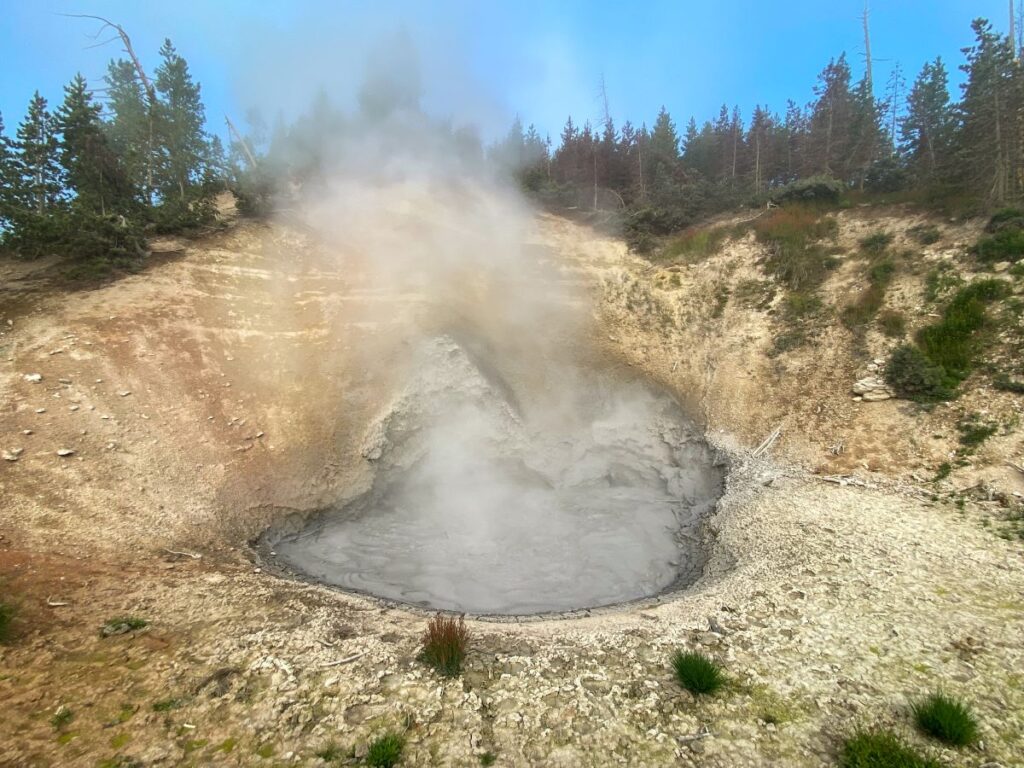
The Mud Volcano area has some of the most acidic hydrothermal features in the entire park.
One of the best features here is the Mud Volcano- a 30 feet by 30 feet volcano-like cone that used to erupt over 50 feet into the air back in the 1800s! It later blew itself apart and left the crater full of bubbling mud that you see today.
The other unique feature is the Dragon’s Mouth Spring. Water and steam boils out of a cave-like opening and makes sounds eerily similar to a dragon breathing. The sounds and smells here are quite incredible.
The only downside to this area is that it is further away from the other geyser basins in Yellowstone. But it is easy to pair with a wildlife-viewing visit to Hayden Valley.
Again, I ranked this area as “skippable” because you can see similar features elsewhere and it can be out of the way depending on your route through Yellowstone.
Lower Geyser Basin & Fountain Paint Pot Trail – Nice to See
Length of hike: 0.5 miles / negligible elevation gain
Time to visit: 30 minutes
Hydrothermal features: geysers, mud pots, hot springs, fumaroles
Best feature: Great Fountain Geyser, mudpots
Best time of day to visit: late afternoon or evening
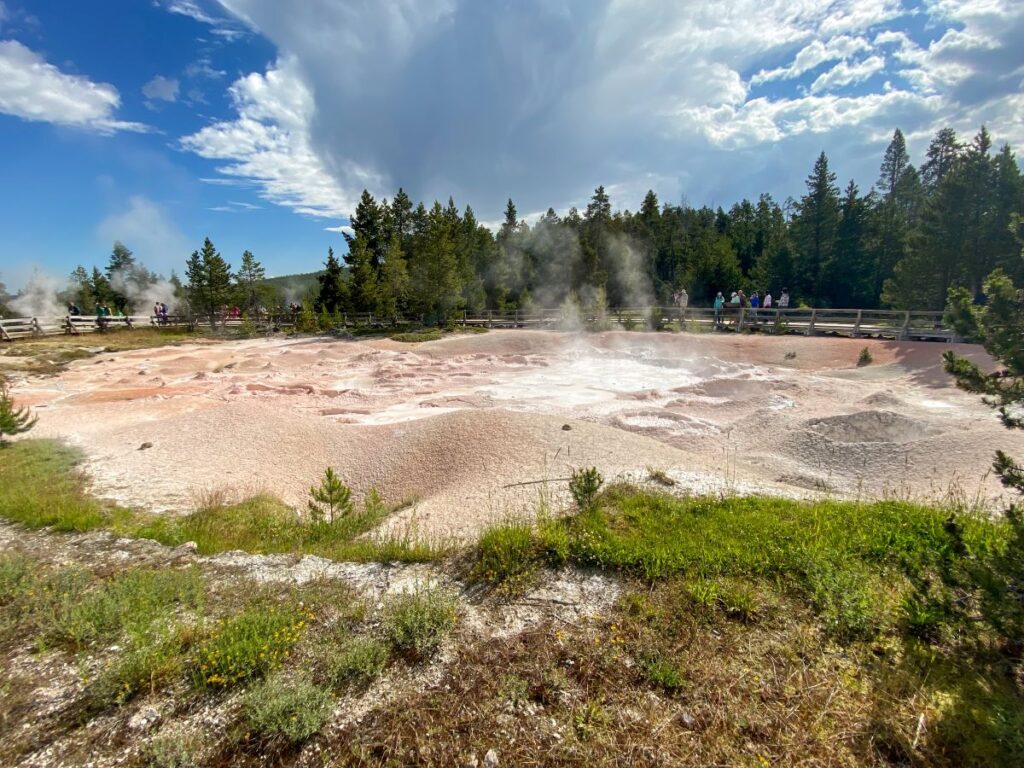
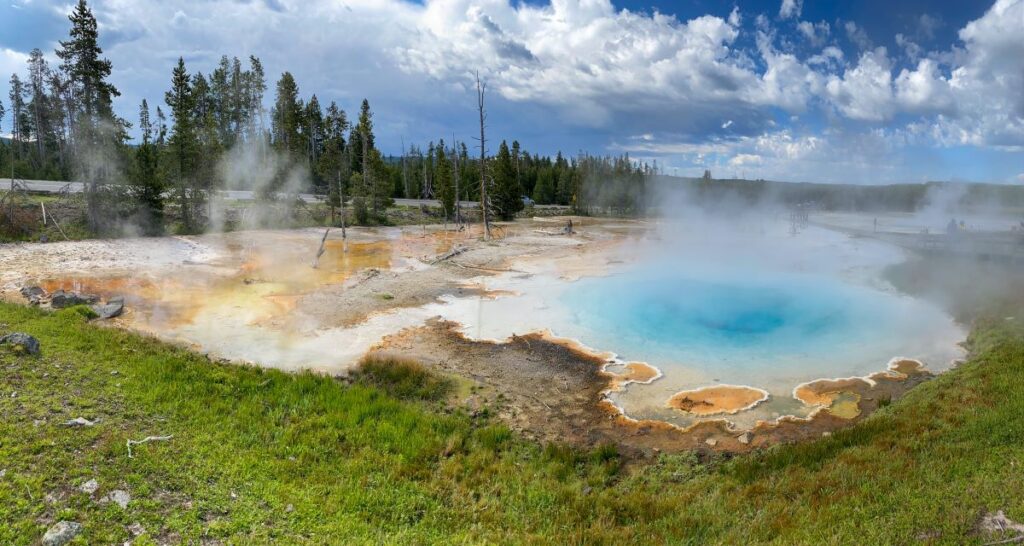
Lower Geyser Basin is the largest Geyser Basin in Yellowstone and covers roughly 11 square miles (Upper Geyser Basin is 1 square mile for reference).
The 2 ways to visit the Lower Geyser Basin are walking the Fountain Paint Pots boardwalk trail and driving Firehole Lake Drive. The Great Fountain Geyser is also located on Firehole Lake Drive and is the only predictable geyser in the Lower Geyser Basin area with 100-foot eruptions every 10-14 hours.
Unfortunately, Firehole Lake Drive was closed when we visited due to a nesting osprey in the area.
I ranked the Lower Geyser basin as “nice to see” since you can see similar features elsewhere, but the visit here is short and convenient when visiting the Old Faithful area.
My suggestion if you’re short on time is to see the mud pots at Artists Paint Pots, and the rest of the hydrothermal features in the Upper Geyser Basin along with Old Faithful.
If you can do those and still squeeze in a visit to Lower Geyser Basin, go for it!
Grand Prismatic Spring & Midway Geyser Basin – Must See
Length of hike: 0.8 miles / negligible elevation gain for the boardwalk trail, 1.5 miles / 200 feet of elevation for the overlook trail
Time to visit: 30 minutes for the boardwalk, 1 hour for the overlook
Hydrothermal features: hot springs
Best feature: Grand Prismatic Spring overlook
Best time of day to visit: midday or late afternoon

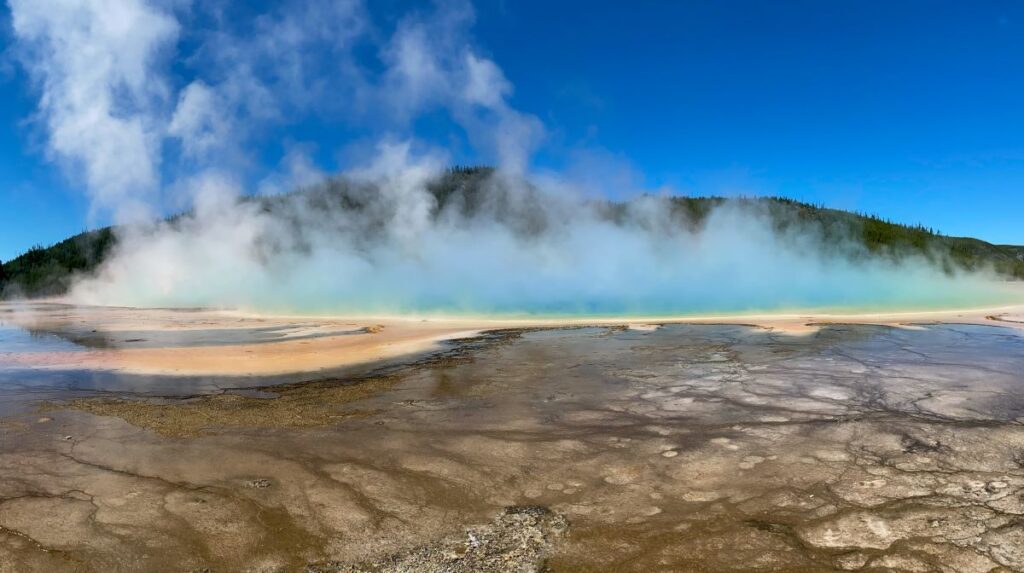
Aside from Old Faithful, Grand Prismatic Spring is probably one of the first things you picture when you think of Yellowstone National Park.
The colors and size of Grand Prismatic Spring are truly iconic. The spring measures over 300 feet in diameter and over 121 feet deep!
There are 2 ways to experience Grand Prismatic Spring: by walking the boardwalks in Midway Geyser Basin and hiking the Grand Prismatic Spring Overlook Trail. Both trails easily make the “must see” list.
At the Midway Geyser Basin Boardwalk Trail, you’ll also see 3 other outstanding hot springs along with the Grand Prismatic Spring: Excelsior Geyser, Opal Pool, and Turquoise Pool.
The best time to visit this area is midday or early evening. If you go too early (before 11 am), the springs are covered with steam and you can’t see the colors (the photo above was taken around 10:45).
Midday is truly best because the direct sunlight illuminates the colors, but the crowds are enormous. It is still worth going at midday and braving the crowds to see the colors, though.
Parking is extremely limited at the Midway Geyser Basin boardwalk trail. Don’t even try to get a parking spot here midday- it is just complete chaos. Park a quarter mile down the road and walk. Your life will be a lot easier this way!
The Grand Prismatic Spring Overlook Trail is located at the Fairy Falls Trailhead. There is a large parking lot here, but it still fills up midday and you’ll likely need to park along the road.
Biscuit Basin – Nice to See
Length of hike: 0.6 miles / negligible elevation gain
Time to visit: 30 minutes
Hydrothermal features: geysers, hot springs
Best feature: Sapphire Pool
Best time of day to visit: midday or late afternoon
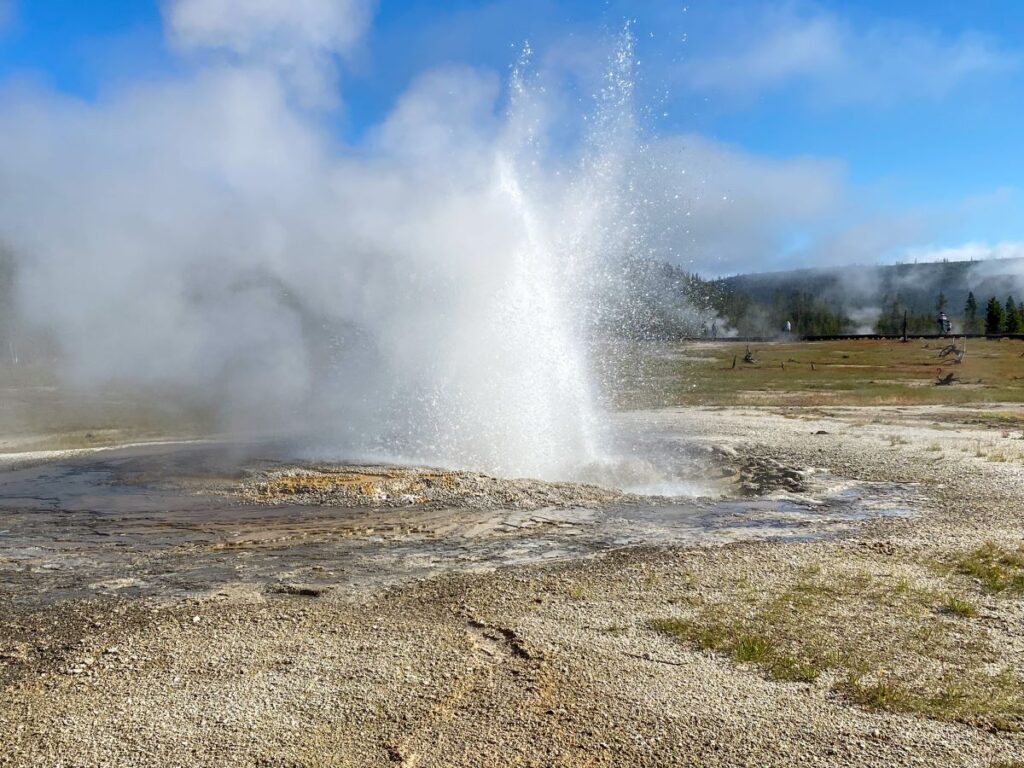
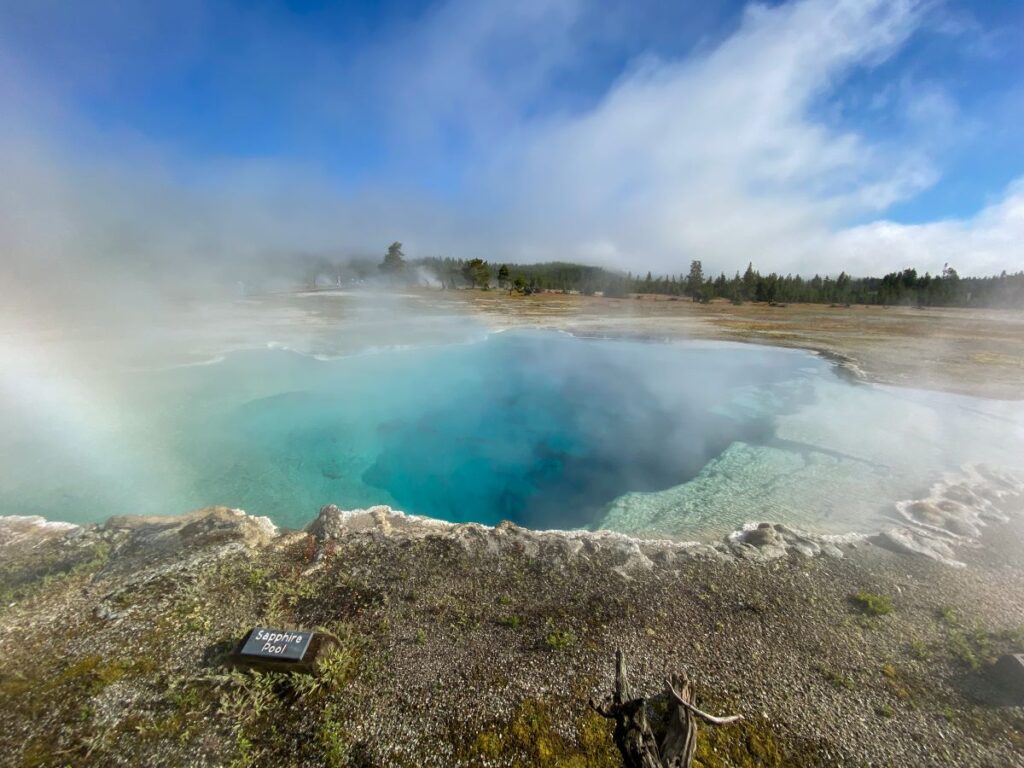
Biscuit Basin was named for the unusual “biscuit” deposits that used to surround the Sapphire Pool, but they have since been blown away.
This is a small geyser basin just north of Upper Geyser Basin. It definitely gets overshadowed by Old Faithful and Grand Prismatic Spring, but some of the prettiest hot springs in the park are located here.
You can hike to Biscuit Basin from the Upper Geyser Basin boardwalk trail, but it will result in a really long walk so I recommend driving here separately. Midday or late afternoon is best so the steam is burned off so you can see the colors!
It’s really easy to combine Biscuit Basin with Midway and/or Upper Geyser Basin and the pools here are gorgeous, so this one made the “nice to see” list
Black Sand Basin – Nice to See
Length of hike: 1 mile / negligible elevation gain
Time to visit: 30 minutes
Hydrothermal features: geysers, hot springs
Best feature: Emerald Pool, Rainbow Pool, Cliff Geyser
Best time of day to visit: midday or late afternoon
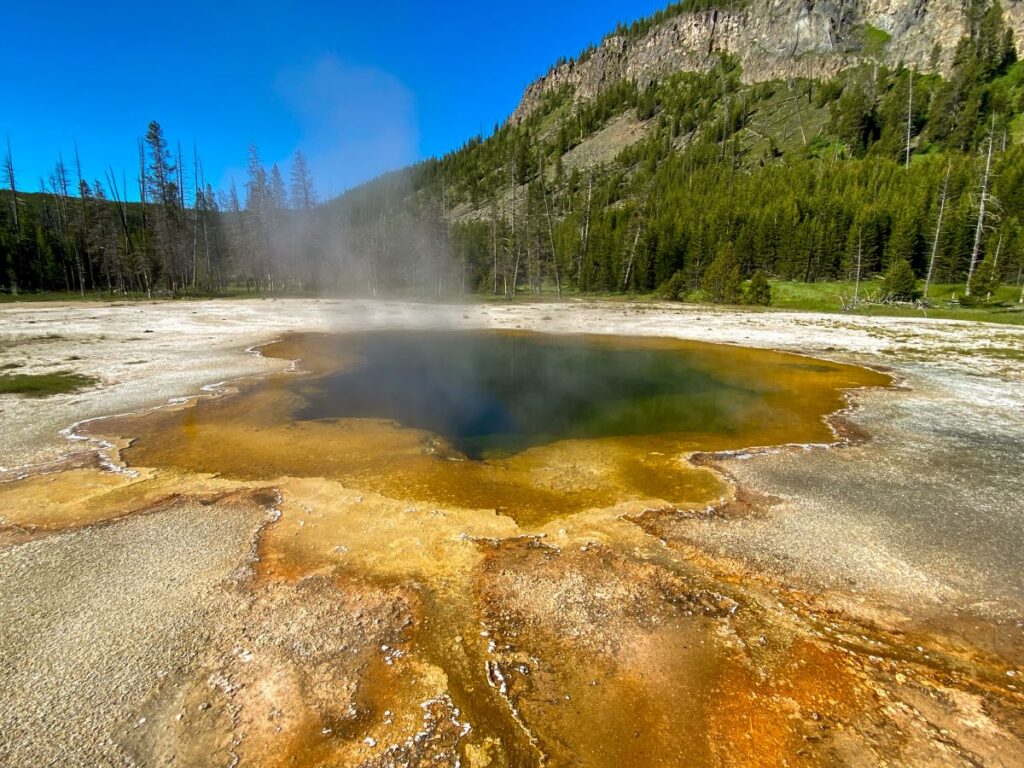
Black Sand Basin is similar to Biscuit Basin in size and proximity to Upper Geyser Basin. You can also hike here from the Upper Geyser Basin boardwalk trail.
Black Sand Basin is named for black volcanic sand that surrounds the area. The highlights here are the Emerald Pool, Rainbow Pool, and the frequently-erupting Cliff Geyser.
A visit here is short and sweet, and really easy to add onto your Grand Prismatic Spring/Upper Geyser Basin itinerary. Therefore, it also made the “nice to see” list along with Biscuit Basin.
Again, I would recommend driving here separately as hiking from the Upper Geyser Basin adds a lot more walking to your (probably) already full day.
Old Faithful & Upper Geyser Basin – Must See
Length of hike: 4.9 miles / 357 feet of elevation gain
Time to visit: 3-5 hours
Hydrothermal features: geysers, hot springs, fumaroles
Best feature: Old Faithful and other active geysers
Best time of day to visit: midday, late afternoon, or evening
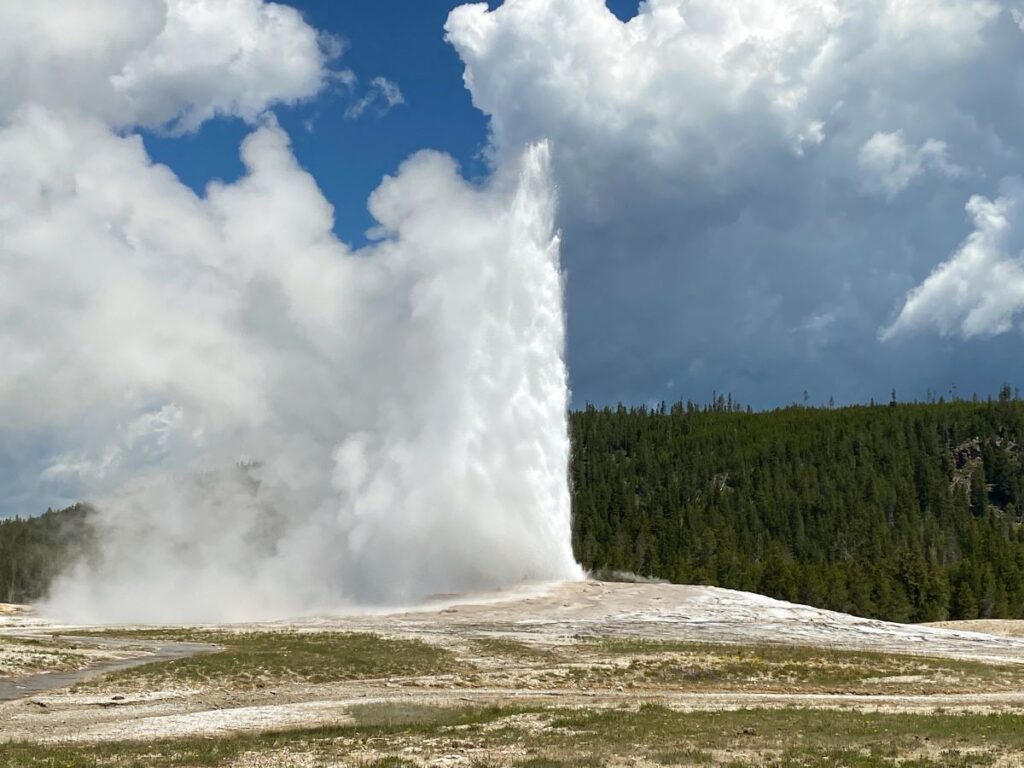
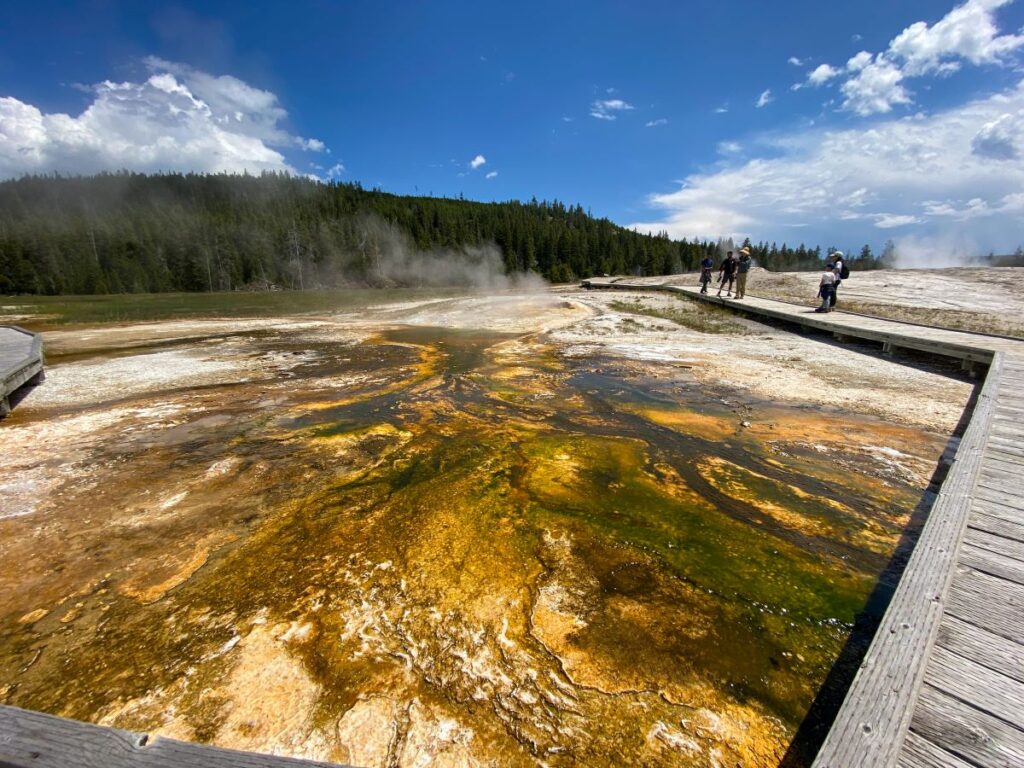
If you only have time to see one thing in Yellowstone National Park, make it Upper Geyser Basin.
It’s most famous for Old Faithful, but there is so much more to see here. Even though the Upper Geyser Basin takes up only 1 square mile, there are over 150 hydrothermal wonders here, making it the most densely concentrated area of geysers in the world.
The Old Faithful area is also the most congested area in the whole park, so bring your patience. The boardwalks are pretty spread out, so once you start walking the crowds spread out a bit and aren’t as bad.
Watch Old Faithful erupt from the viewing platform (the approximate times are posted throughout the area) and then spend the afternoon walking the extensive network of boardwalks.
You can additionally watch Old Faithful from Observation Point, a short but steep hike off the Upper Geyser Basin boardwalks up to an overlook with a great view of the world’s most famous geyser. We actually never made it up here because there was a bison in the trail when we attempted the hike!
This area also has a handful of smaller geysers with frequent, somewhat predictable eruptions. You might get lucky and see one or more eruptions while you’re exploring the boardwalks!
Other highlights of this area are the Morning Glory Pool, Beauty Pool, Grand Geyser, and Castle Geyser.
This area made the “must see” list because you can see almost every hydrothermal feature in Yellowstone along with the famous Old Faithful.
Related: Visiting the Old Faithful Area of Yellowstone (How to Beat the Crowds, Tips, & More!)
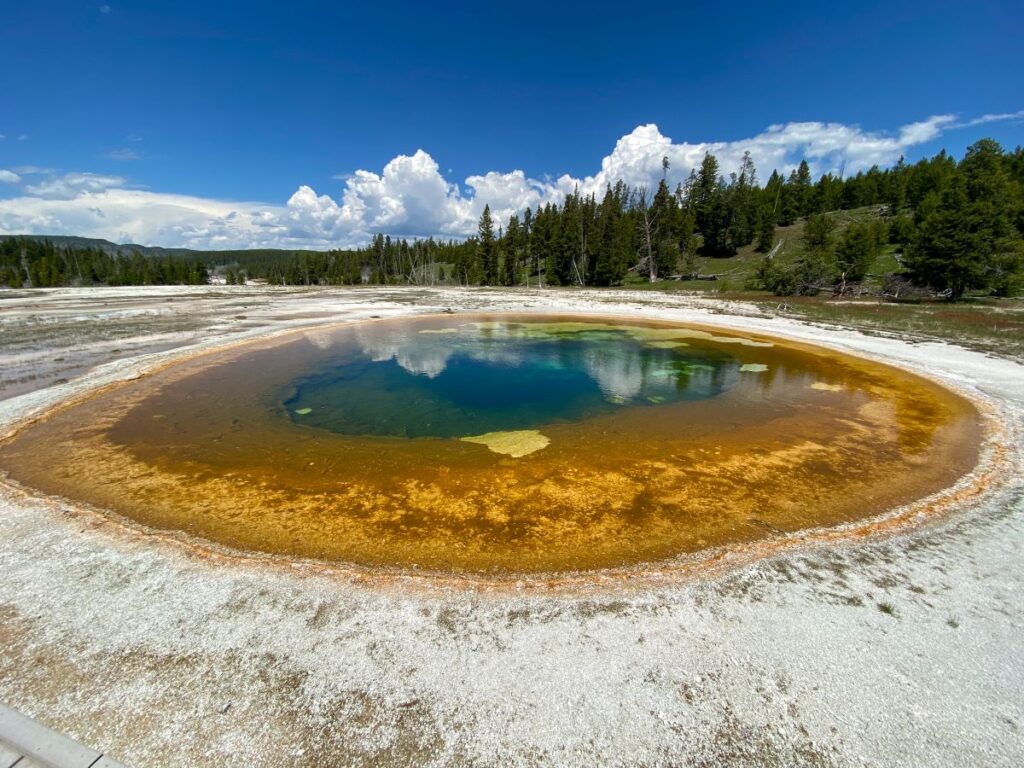
West Thumb Geyser Basin – Nice to See
Length of hike: 1 mile / negligible elevation gain
Time to visit: 30 minutes
Hydrothermal features: hot springs
Best feature: Abyss Pool, Fishing Cone, seeing hot springs right on Lake Yellowstone
Best time of day to visit: midday, late afternoon, or evening
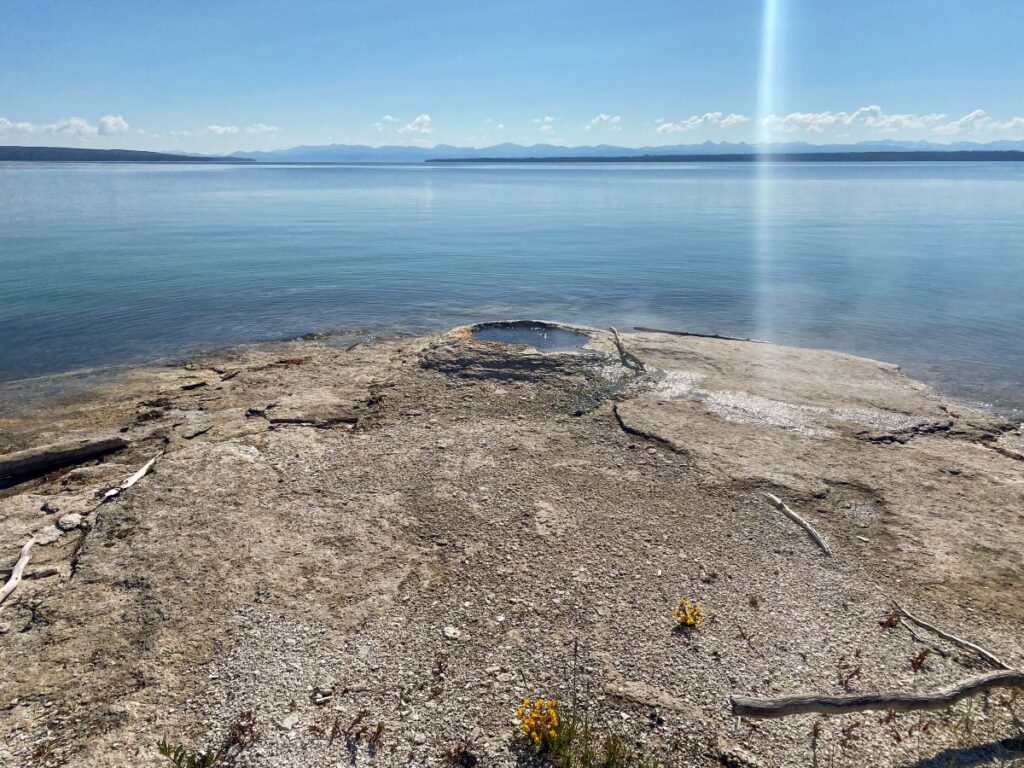
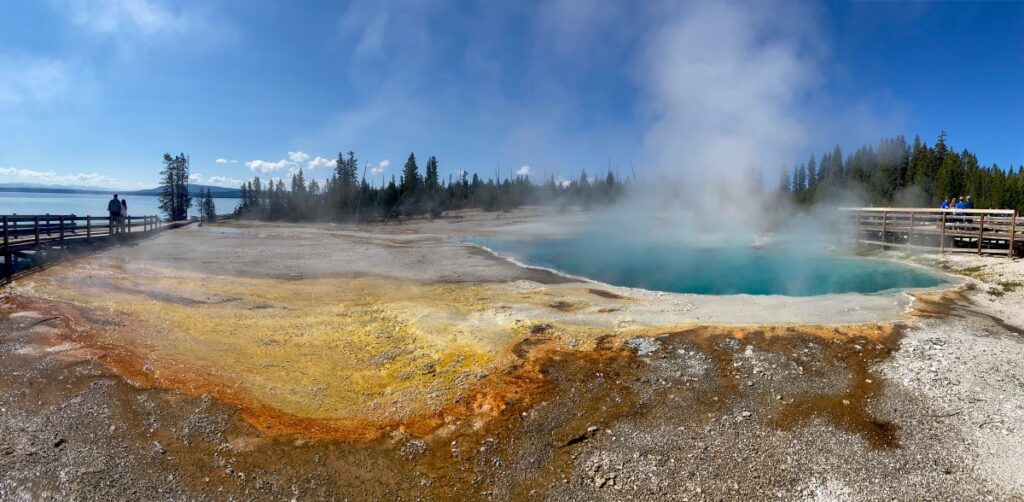
West Thumb Geyser Basin is unique because it is located right on the Yellowstone Lake. A stop here is short and sweet, plus it is less crowded than some of the other geyser basins in Yellowstone.
There are some colorful hot springs on this boardwalk trail along with a great view of the lake.
This geyser basin makes a great stop on the way to or from Grand Teton National Park as you enter or exit Yellowstone from the south entrance.
West Thumb Geyser Basin earned the rank of “nice to see” since it is a unique area that is quick and easy to visit, but would not be on the top of my list of best geyser basins in Yellowstone.
Where to Stay When Visiting Geyser Basins in Yellowstone
Old Faithful is by far the most central and convenient location for visiting geyser basins in Yellowstone.
You have the choice of 3 lodging options here:
- Old Faithful Inn: The oldest log cabin structure in the world. You can splurge on a room with a view of Old Faithful, or go more economical with a bunk room with a shared bathroom (what we did).
- Old Faithful Snow Lodge: One of the only lodging facilities that is open in both the summer and winter seasons.
- Old Faithful Lodge Cabins: The most budget-friendly option with choices of cabins with private and communal bathrooms.
Yes, it is expensive staying in the park and there aren’t as many included amenities, but location is key when visiting Yellowstone. Strategically planning to stay near the best attractions will save you literally hours of driving on your trip.
The in-park accommodations sell out really fast, so it’s best to book them a year in advance!
If Old Faithful is already booked up for the dates of your trip, West Thumb (Grant Village) and West Yellowstone aren’t bad options either.

Yellowstone Geyser Basin Itinerary
Here’s how I would structure 1 or 2 days to visit geyser basins in Yellowstone, going north to south. Reverse these itineraries if you are coming from the south!
If you do either of these itineraries, I highly recommend staying in Old Faithful or Grant Village if you’re coming from the north, or staying in Mammoth or Gardiner if you are coming from the south.
Related: Yellowstone in One Day: 7 Best Yellowstone Road Trip Itineraries
1-Day Yellowstone Geyser Basin Itinerary
If you only have 1 day to visit the geyser basins in Yellowstone, you can hit all of the must see areas if you start early and are efficient with your time.
Morning: Mammoth Hot Springs and Artists Paint Pots
Start your day early and visit the Mammoth Hot Springs (try to get here before 8 am if you can). Grab supplies for a picnic lunch in Mammoth and then head south on Grand Loop Road and visit the Artists Paint Pots.

Midday: Old Faithful and Upper Geyser Basin
Head down to Old Faithful and eat your picnic lunch at the Old Faithful viewing platform and watch the next eruption. Walk the boardwalks at the Upper Geyser Basin after the eruption.
Afternoon: Grand Prismatic Spring and Midway Geyser Basin
When you’re done at Old Faithful, head north toward Grand Prismatic Spring and Midway Geyser Basin. Don’t even try to get a parking spot in the lot- just park along the street and walk (trust me, it is not worth your time).
Walk the boardwalks at Midway Geyser Basin and then head over to the Fairy Falls Trailhead to hike to the Grand Prismatic Spring Overlook.
Evening: Biscuit, Black Sand, and Lower Geyser Basin or Norris Geyser Basin (optional)
Grab dinner at Old Faithful and then venture out after your meal if you’re up for it. If you’re tired of walking (Upper Geyser Basin can be a lot of walking!), I’d recommend checking out Biscuit, Black Sand, and Lower Geyser Basin since they are all close by and quick to visit.
If you’re up for a longer walk, I’d recommend backtracking a bit and visiting Norris Geyser Basin.
And of course, if you’re exhausted from the day you could always relax in your hotel (or grab a beer at the Old Faithful Inn and watch another eruption from the second floor hotel viewing deck!).

2-Day Yellowstone Geyser Basin Itinerary
The 2-day geyser basin itinerary will allow you to see all of the “must see” and “nice to see” geyser basins in Yellowstone.
Day 1
Morning: Mammoth Hot Springs and Artists Paint Pots
Start your day early and visit the Mammoth Hot Springs first thing. On your way down to the Old Faithful area, stop at the Artists Paint Pots.
Midday: Grand Prismatic Spring and Midway Geyser Basin
Grab lunch at one of the cafeterias or general stores at Old Faithful, and then make your way over to the Grand Prismatic Spring and Midway Geyser Basin boardwalk trail.
Don’t even try to get a parking spot in the lot- just park along the street and walk (trust me, it is not worth your time).
Walk the boardwalks at Midway Geyser Basin and then head over to the Fairy Falls Trailhead to hike to the Grand Prismatic Spring Overlook.
Afternoon: Relax in your hotel
Check into your hotel and relax for a few hours during the most crowded hours.
Evening: Norris Geyser Basin
Spend the evening exploring Norris Geyser Basin after 4 pm. Feel free to eat dinner before or after.
If you’re staying in Old Faithful, grab a couple of drinks when you’re done exploring Norris and head to the second floor viewing platform at the Old Faithful Inn and watch another eruption or two!
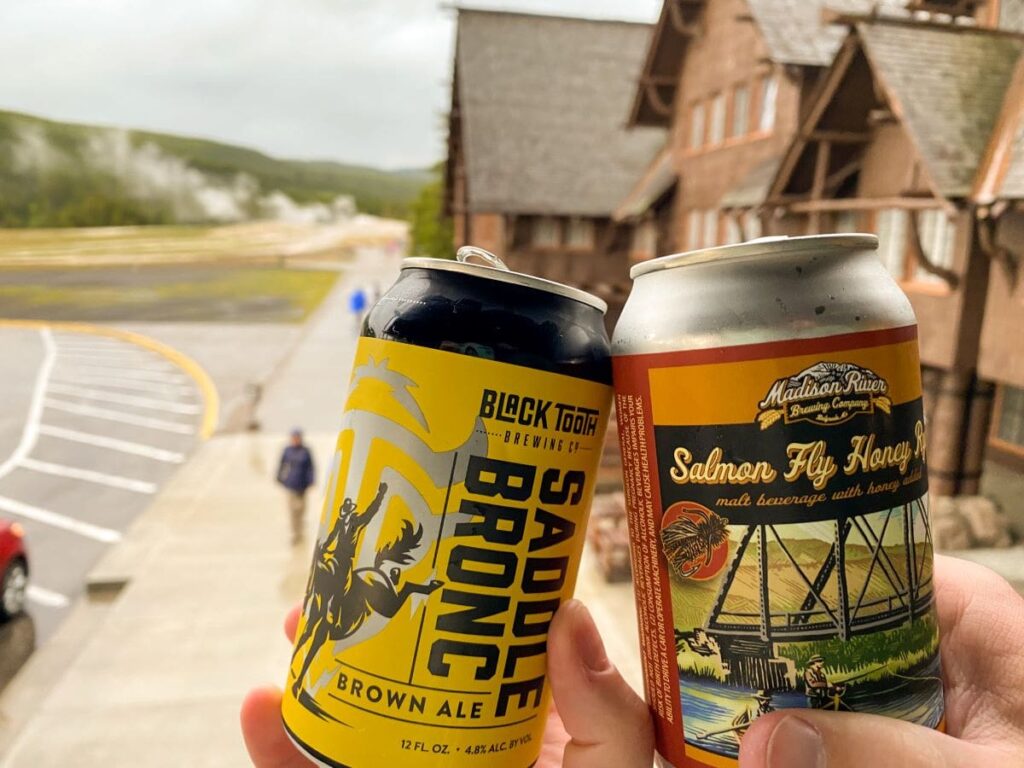
Day 2
Morning: Relax in your hotel
I know it sounds counter-intuitive, but spend the morning relaxing in your hotel, souvenir shopping, and/or watching Old Faithful erupt if you stayed in the Old Faithful Inn.
The larger hot spring pools are covered in steam in the mornings, so it’s hard to get a good look at them until the steam burns off midday.
Midday: Old Faithful and Upper Geyser Basin
Watch Old Faithful erupt from the boardwalk viewing platform and then walk the Upper Geyser Basin boardwalk. Hike up to Observation Point if you want a birds’ eye view of the basin (and if you time it right, you can watch another Old Faithful eruption from here!).
Afternoon: Biscuit, Black Sand, and Lower Geyser Basin (optional)
If you’re not too tired, spend the afternoon visiting the Biscuit, Black Sand, and Lower Geyser Basin. These are all small geyser basins close by, so they are easy and quick to visit.
Of course, if you’re tired, feel free to take a break in your hotel or get on the road toward your next destination. I would recommend stopping at the West Thumb Geyser Basin on your way out of town though!
Evening: West Thumb Geyser Basin
On your way out of town (whether you’re leaving Yellowstone from the south entrance, or looping back up north toward Canyon Village), stop at the West Thumb Geyser Basin on your way.
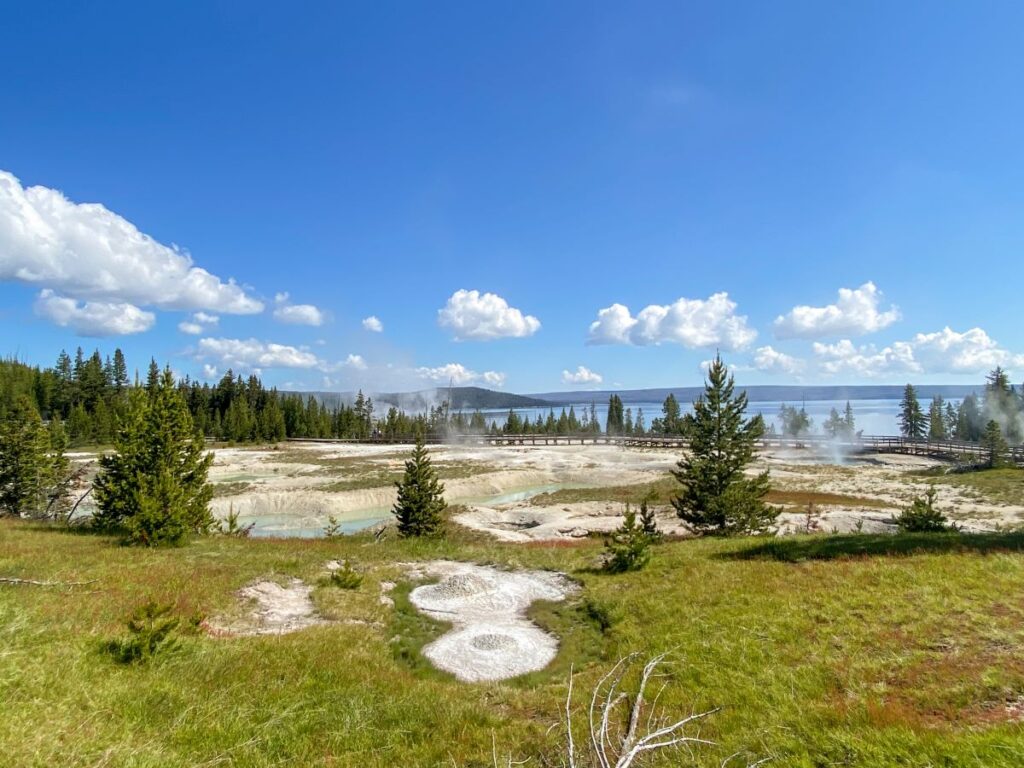
Yellowstone Geyser Basins Summary
If I had to rank all 11 geyser basins in Yellowstone from top to bottom (a rank of 1 being the highest), here’s how I would rank them.
I’ve also put the “must see,” “nice to see,” and “skippable” ranking next to each one.
- Old Faithful & Upper Geyser Basin – must see
- Grand Prismatic Spring & Midway Geyser Basin – must see
- Mammoth Hot Springs – must see
- Artists Paint Pots – must see
- Norris Geyser Basin – nice to see
- West Thumb Geyser Basin – nice to see
- Biscuit Basin – nice to see
- Black Sand Basin – nice to see
- Lower Geyser Basin – nice to see
- Monument Geyser Basin – skippable
- Mud Volcano – skippable
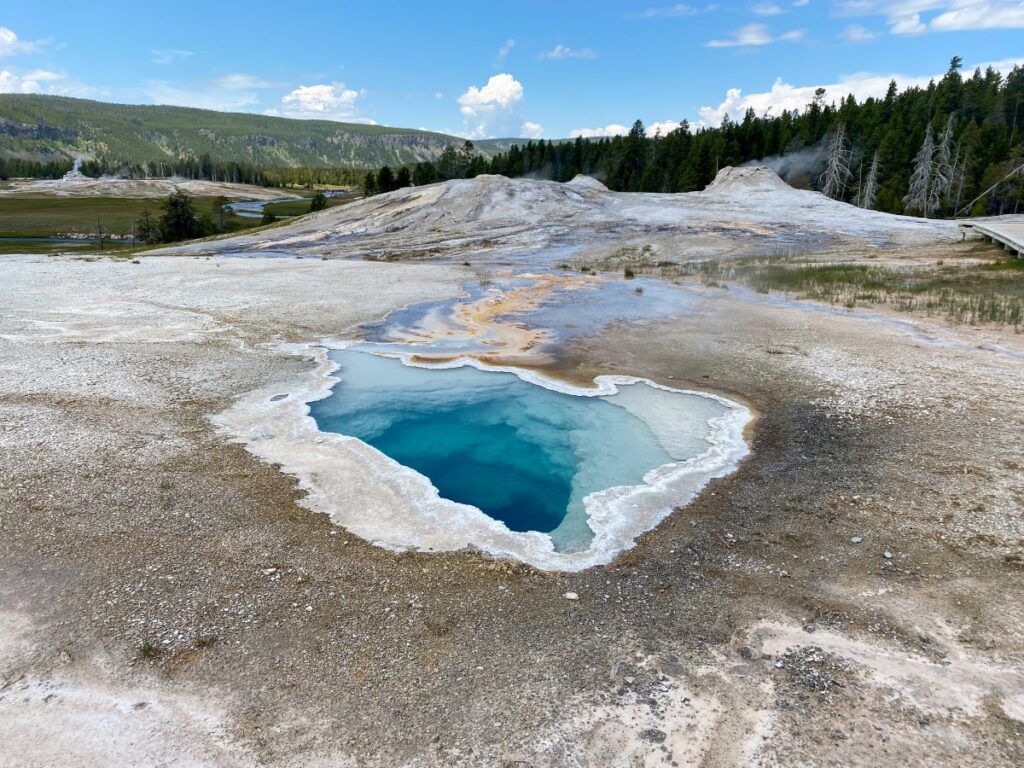
Yellowstone Geyser Basin FAQs
Where is the Best Place to See Geysers in Yellowstone?
The best place to see geysers in Yellowstone is at Old Faithful and the Upper Geyser Basin. The Upper Geyser Basin is home to 5 large, active geysers: Old Faithful, Grand, Daisy, Castle, and Riverside.
What is the Best Time of Day to Visit Old Faithful?
The best time to visit Old Faithful and the Upper Geyser Basin is afternoon through evening. Old Faithful is busiest between 10 am and 6 pm (basically all day), but there is plenty of room at the viewing platform and the Upper Geyser Basin boardwalks are widespread enough to mitigate the crowds.
Avoid going too early in the morning, as the hot spring pools will be covered in steam, making it hard to see the vibrant colors of the pools!
Where is the Best Place to See Hot Springs in Yellowstone?
The most vibrant and impressive hot spring in Yellowstone is the Grand Prismatic Spring located in Midway Geyser Basin. Other areas to see the best hot springs are in the Upper Geyser Basin, Biscuit Basin, Black Sand Basin, Norris Geyser Basin, and West Thumb Geyser Basin.
Which Geyser Basin in Yellowstone is Best?
The best geyser basin in Yellowstone is the Upper Geyser Basin. You’ll see the world’s most famous geyser, Old Faithful, along with 4 other active geysers and over 100 hot springs.
If you only have time to see one geyser basin in Yellowstone, make it the Upper Geyser Basin. Midway Geyser Basin and Grand Prismatic Spring is a close second, though!
What is the Tallest Geyser in Yellowstone?
The tallest, most active geyser in Yellowstone is Steamboat Geyser, located in Norris Geyser Basin. Eruptions are somewhat predictable and shoot water more than 300 feet in the air.
Where is the Best Place to See Mud Pots in Yellowstone?
The best place to see mud pots in Yellowstone is at the Artists Paint Pots and the Fountain Paint Pot Trail in Lower Geyser Basin. Additionally, the Mud Volcano area has the largest bubbling mud pot in the park.
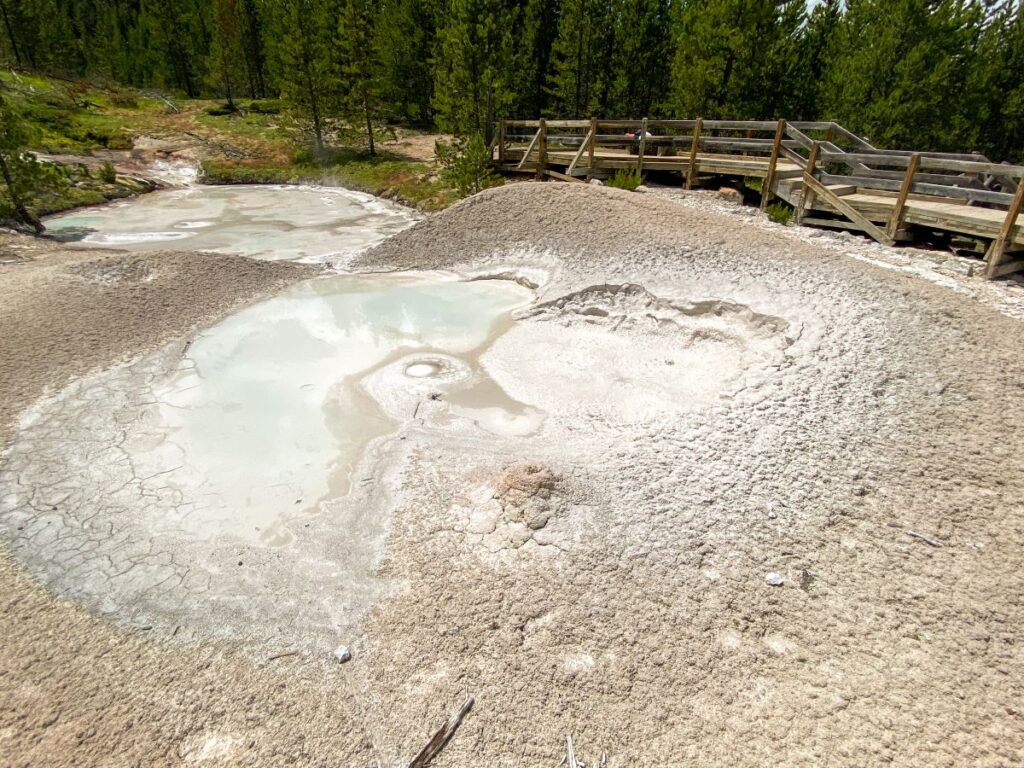
What is your favorite geyser basin in Yellowstone? Do you agree or disagree with any of my rankings? Let me know in the comments below!
-Megan
If You Have More Time in Yellowstone National Park
Check out my other posts on Yellowstone to help you make the most of your visit!
- The Ultimate 1-5 Day Yellowstone Itinerary
- Yellowstone in One Day: 7 Best Yellowstone Road Trip Itineraries
- The Ultimate Yellowstone Bucket List: Top 17 Things to See & Do
- The Ultimate 9-Day Yellowstone and Grand Teton Road Trip Itinerary (+ Maps, Photos, & More!)
- The Complete Guide to All 5 Yellowstone Entrances
- Visiting the Old Faithful Area of Yellowstone (How to Beat the Crowds, Tips, & More!)
- The Ultimate Guide to the Grand Canyon of the Yellowstone
- Yellowstone National Park North Entrance: A Complete Guide
- 12 Essential Tips for Visiting Yellowstone in the Summer
- Beartooth Highway Scenic Drive Guide (With Tips & Photos!)

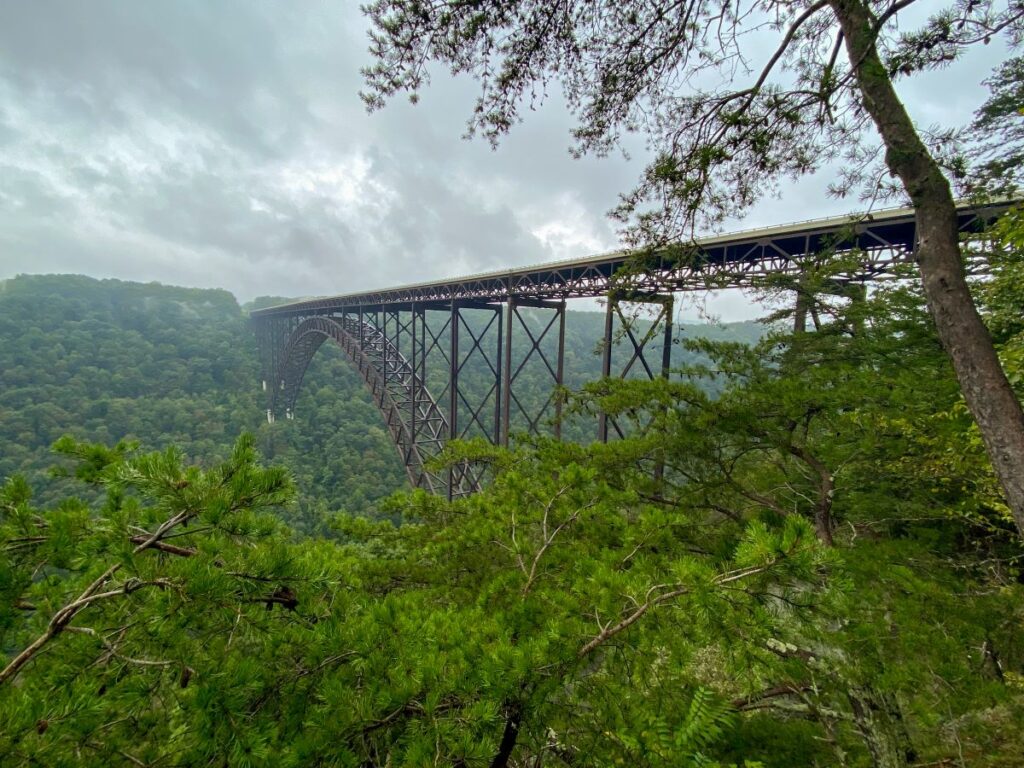
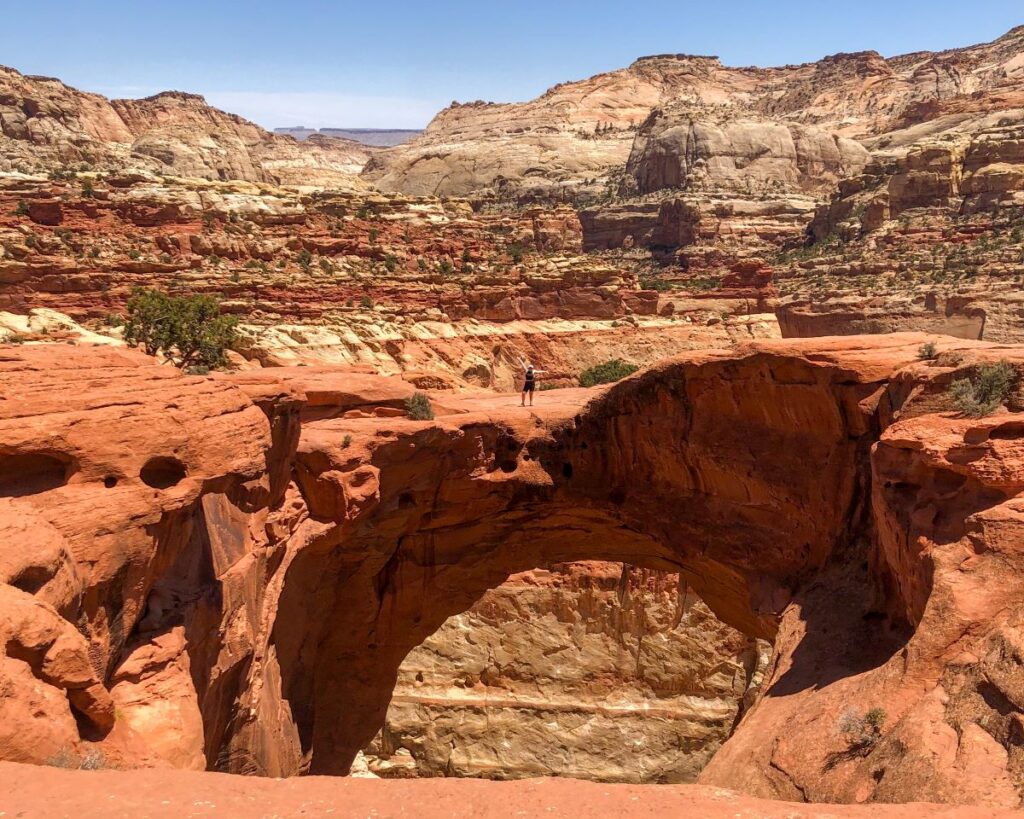
Pingback: Yellowstone National Park North Entrance: A Complete Guide - Engineer to Explore
Great post! Thank you
Thanks for the comment! Glad the post helped:)